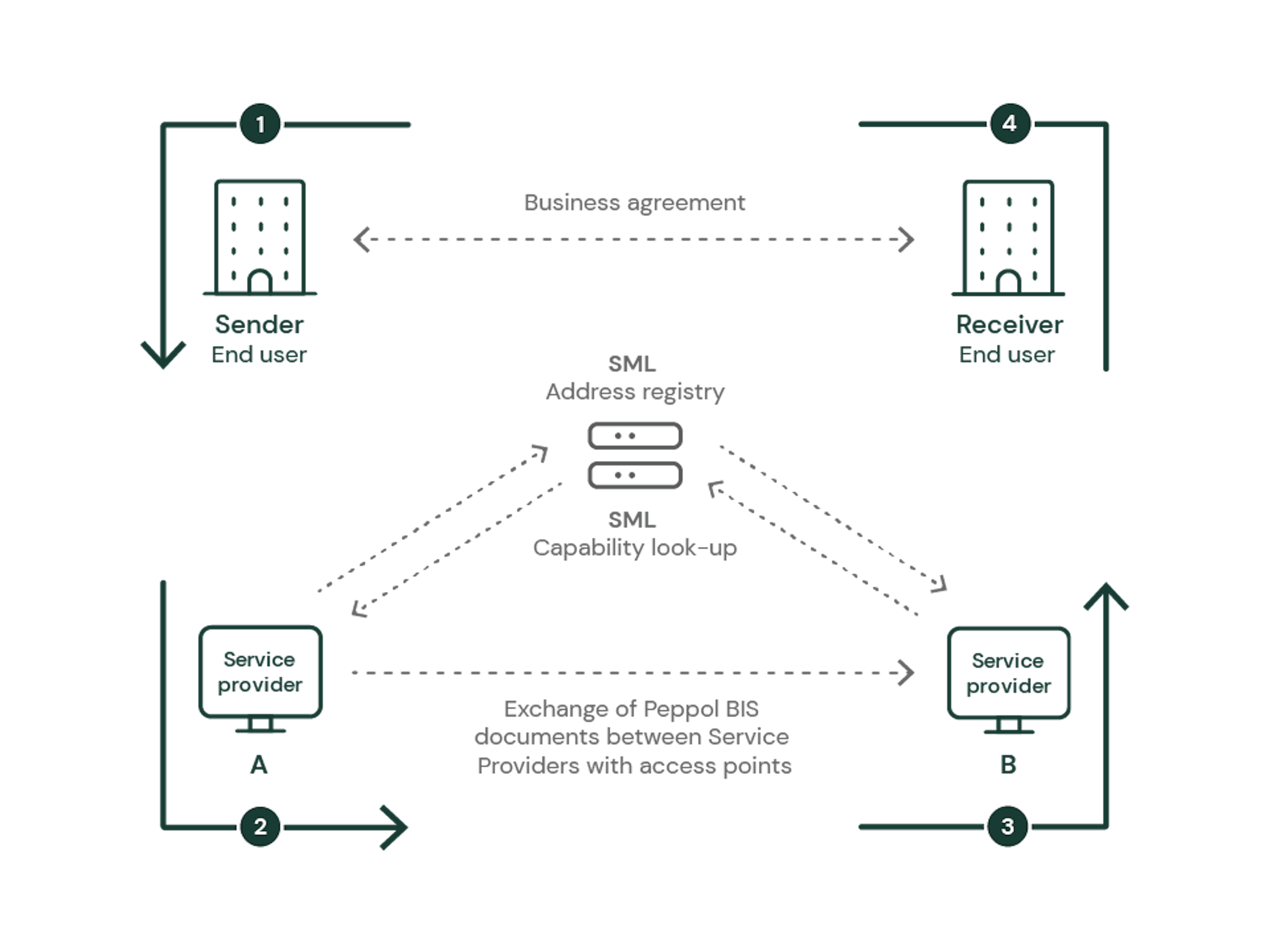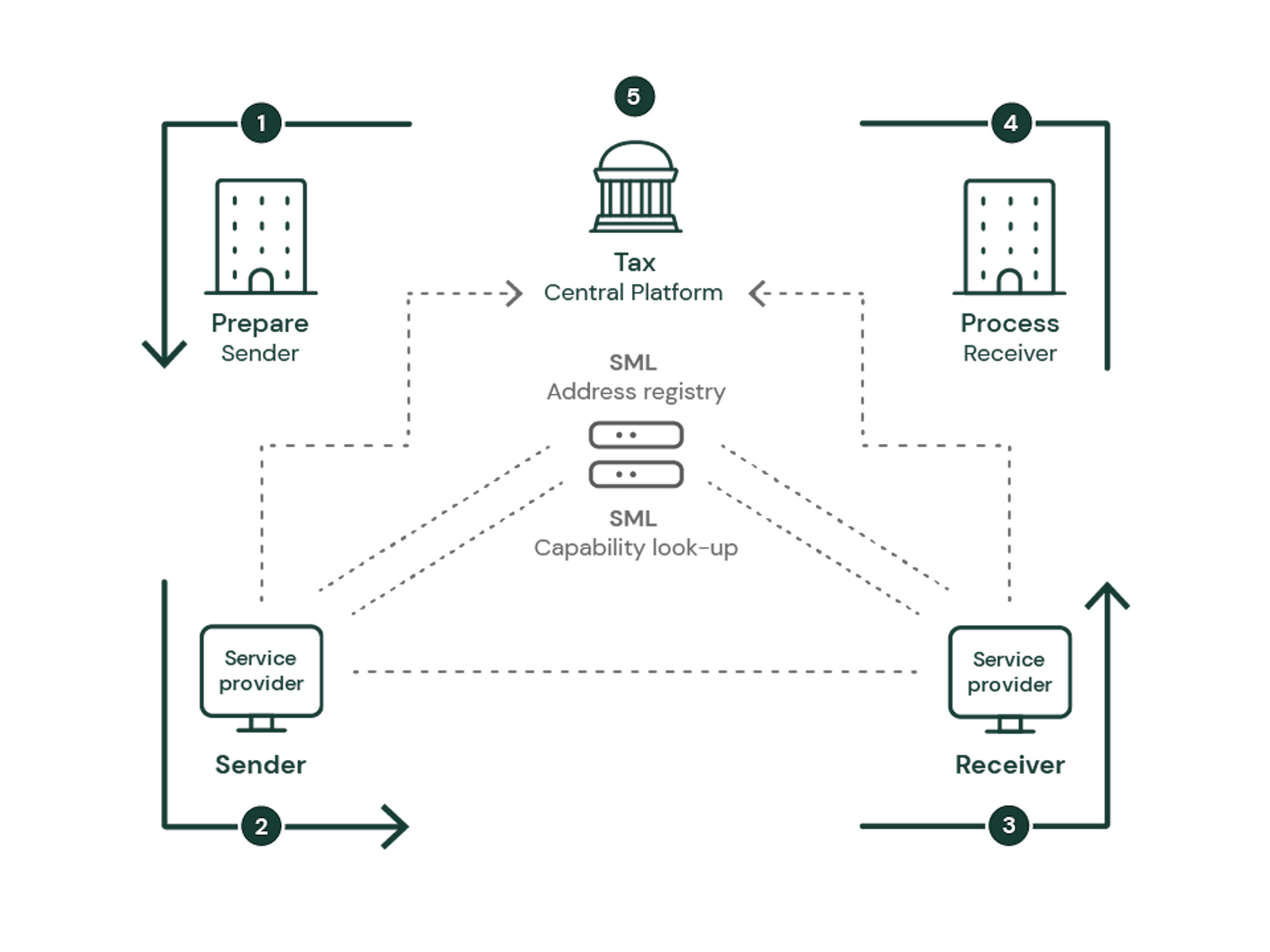Picture a world where businesses can exchange documents effortlessly without juggling between formats or navigating various platforms. Thanks to Peppol, this vision is becoming a reality. With its growing global footprint, Peppol is reshaping the landscape of e-document exchange, making business communication simpler and more unified across continents.
In this article, Pagero's Head of Regulatory Affairs and Chair of OpenPeppol, Nazar Paradivskyy, provides an in-depth exploration of Peppol. He'll uncover the intricacies of the Peppol network and address the most frequently asked questions.
Table of contents
- A short intro to Peppol
- Global adoption of Peppol: A journey from Europe to the world
- Understanding the key players of Peppol
- Decoding Peppol's terminology
- How Peppol works
- Peppol Network: a contrast to centralised systems
- Benefits of using Peppol for global commerce
- Embracing the future with Peppol
What exactly is Peppol?
Peppol (formerly known as PEPPOL) stands for Pan-European Public Procurement On-Line. It’s a framework for the secure cross-border exchange of electronic business documents. Peppol is not a platform for document exchange but rather a network that connects the many existing platforms already used by businesses and public entities. It's an IT infrastructure that makes it possible to connect and send messages to other systems connected to the network.
It began in 2008 with a mission to streamline trade between European governments. But today, its role is global, serving as a universal framework for e-document exchange between entities worldwide.
The credit card analogy
To better understand Peppol, just think about your credit card. Visa or Mastercard don't manage the individual transactions at your local coffee shop; instead, they provide the governance — the rules, standards, and infrastructure — that allows your card to be accepted at millions of places around the world. Similarly, Peppol doesn't handle the direct exchange of invoices or other documents but provides the framework that enables these documents to be exchanged securely and seamlessly across various platforms.
A short intro to Peppol
Listen as Hertzbert Casseus, Regulatory Associate at Pagero explains how Peppol facilitates seamless e-invoice and e-document exchanges, reducing manual handling and enhancing efficiency.

Global adoption of Peppol: A journey from Europe to the world
The global expansion of Peppol reflects the increasing recognition of its potential to streamline procurement processes and enhance cross-border trading efficiency.
Singapore was one of the first non-European countries to recognise the advantages of Peppol, integrating it into its nationwide e-invoicing network. Australia and New Zealand followed, embracing Peppol to improve the efficiency and interoperability of their digital economies. Along with the Peppol PINT launch, Japan and Malaysia also obtained authority status and joined the Peppol implementation.
Countries are exploring Peppol's capabilities and considering its implementation to enhance their e-invoicing and e-procurement systems. This interest is part of a broader push towards digital transformation and economic integration in the region.
Understanding the key players of Peppol
The growing interest in Peppol can be viewed as a means to accelerate digital trade and government procurement processes. As these regions focus on digital innovation and economic diversification, Peppol stands out as a promising enabler.
So, how is Peppol structured and governed? Who are the key players that keep the Peppol network functioning smoothly?
OpenPeppol: At the helm of the Peppol network sits OpenPeppol, a non-profit organisation responsible for the stewardship and strategic evolution of Peppol. Born from the collective aspirations of its members, OpenPeppol orchestrates the network's standards and frameworks, fostering an environment where interoperability is the norm, not the exception. It's the custodian of the Peppol specifications, governing the network with an eye on ensuring consistency, security, and compliance across all interactions.
Peppol Authority: Functioning as the regulatory beacons within the Peppol ecosystem are the Peppol Authorities. These are designated organisations, often tied to government bodies or sectors, overseeing the Peppol framework within specific territories or markets. Their mandate includes accrediting Service Providers, monitoring compliance with Peppol standards, and facilitating local adoption. These authorities serve as regional anchors, ensuring that the universal principles of Peppol are tailored to meet local requirements and legal frameworks.
Service Provider: (formerly known as Access Point) The arteries of the Peppol network are the Service Providers, previously referred to as Access Points. These entities deliver the technological infrastructure that enables participants to send and receive e-documents through Peppol. Acting as gateways, they translate business documents into a common Peppol format, allowing for a frictionless exchange of information between disparate systems. Businesses connect to a Service Provider, which then handles the secure transfer of documents to any other entity within the Peppol network, regardless of its location or sector.
Peppol Communities: Finally, the lifeblood of Peppol's existence is its communities—clusters of users and stakeholders, including businesses, government entities, and service providers. These groups are collaborative forums where best practices are shared, and knowledge is disseminated. Within these communities, members can discuss implementations, innovations, and adaptations to their evolving business needs or regulatory landscapes. These communities not only foster collaboration but also encourage the collective advancement and refinement of the Peppol standards.
In sum, the architecture of Peppol is upheld by a framework where each player contributes to the network's robustness and vitality, ensuring that the business language spoken across the globe is coherent, connected, and continuous. Understanding the roles and interactions of these players is vital for any entity looking to navigate the Peppol ecosystem successfully.
Decoding Peppol's terminology
Peppol comes with its own set of terms that can seem like a jargon maze to the uninitiated. Here's a breakdown of the key concepts to help you navigate the Peppol network with ease:
Peppol BIS & PINT: Peppol BIS (Business Interoperability Specifications) are the building blocks of the network's communications. They're like the grammar rules for the language Peppol speaks, ensuring that documents sent from one business to another are understood correctly, no matter where they are in the world.
PINT (Peppol International invoicing) is a subset of these specifications, specifically tailored to achieve interoperability and provide flexibility to support unique local requirements, making sure that invoices can be sent between countries without a hitch.
Peppol AS4: This is the protocol, or method, that Peppol uses to transfer documents securely. It's a set of rules that ensures all the data sent across the network is safe and arrives at its destination without being tampered with, like a sealed delivery van carrying a valuable package.
SMP, SML, and Directory: The Service Metadata Publisher (SMP) is a directory where each business's delivery address in the Peppol network is listed. The SML (Service Metadata Locator) is like the central address book that helps find the correct SMP for any given business within the network. Together, they work like a postal system, making sure your documents reach the right mailbox. The Peppol Directory is a public address book where you can find entities within the Peppol network, similar to a phone directory but for Peppol participants.
PASR (Peppol Authority Specific Requirement): PASR is a set of additional rules or standards that a local Peppol Authority might require on top of the standard Peppol rules. It's like having community-specific guidelines within a larger city's regulations.
KYC in Peppol: KYC, or Know Your Customer, is a process borrowed from the finance industry, and in Peppol, it refers to the identification and verification of businesses within the network. It's about making sure that every participant is who they say they are, adding a layer of trust to the transactions, similar to showing ID when you receive a registered letter. By understanding these terms, you'll be better equipped to grasp how the Peppol network functions and how it can facilitate seamless, secure, and standardised electronic document exchanges across borders.
Peppol: The governance behind global e-document exchange
Understanding how Peppol operates is key to recognising its role in revolutionising the way businesses communicate worldwide. It’s worth reminding ourselves that Peppol is not a singular platform where documents are exchanged. It's a set of rules and standards—a governance framework—that allows different e-invoicing platforms to communicate with each other. This system ensures that a document sent from one corner of the globe can be received and understood in another, regardless of the local platforms each business uses.
How Peppol works
When a business wants to send an invoice, it creates the document using its own accounting software. This software is set up to be Peppol-compliant, meaning it can 'speak' and 'understand' the Peppol language, thanks to following the BIS specifications. Once the invoice is ready, it's sent to a Peppol Service Provider—sometimes still referred to as an Access Point.
This service provider acts as a bridge between the sender's software and the recipient's platform. It translates the invoice into the standard Peppol format and sends it across the network using the secure AS4 protocol. The recipient's service provider receives the invoice, converts it back into a format that the recipient's software can understand, and delivers it.
Throughout this process, the Service Metadata Publisher (SMP) and Service Metadata Locator (SML) play crucial roles in directing the traffic, ensuring the document is sent to the correct address. The Peppol Directory can be used to look up these addresses, much like you might use an online phone book.
The benefits of Peppol's Governance Model
The beauty of Peppol's governance model is that it removes the complexity of dealing with different national standards and formats for e-invoicing. Businesses don't have to worry about whether their documents will be compatible with the recipient's systems as long as both are using Peppol-compliant software and Service Providers. This uniform approach also makes compliance with various international e-invoicing regulations more straightforward.
Choosing your Peppol Service Provider
Peppol Network: a contrast to centralised systems
The Peppol network provides a distinct approach to electronic document exchange, setting it apart from national systems such as KSeF in Poland or SDI in Italy, which can be described as centralised models. Let's delve into what makes Peppol's framework unique and how it differs from these country-specific solutions.
Peppol's 4-Corner Model: The essence of Peppol's 4-corner model lies in its decentralised nature and the flexibility it provides:
Corner 1 (C1): sender - This is the business or entity that initiates the electronic document, such as an invoice.
Corner 2 (C2): sender's Peppol Service Provider (SP) - The sender's software communicates with a service provider, which is essentially a gateway to the Peppol network.
Corner 3 (C3): receiver's Peppol Service Provider (SP) - On the receiving end, another service provider takes the document from the Peppol network and delivers it to the intended recipient.
Corner 4 (C4): receiver - This is the business or entity that the electronic document is being sent to.

Between corners 2 and 3 is where the Peppol network operates, enabling documents to move between service providers. Each service provider can connect with any other as long as they comply with Peppol's standards, creating a vast interoperable network.
Centralised/Clearance Model: In contrast, national systems like KSeF and SDI operate on a single platform:
Corner 1: sender - As with Peppol, this is the entity generating the invoice.
Corner 2: centralised national platform - Instead of sending the document through an independent service provider, it is sent to a centralised government-controlled platform (KSeF in Poland and SDI in Italy).
Corner 3: receiver - The document is then delivered directly to the receiver from the centralised platform.
Peppol’s 5-Corner Model (Peppol CTC) provides a robust infrastructure that aligns with the objectives of CTC (continuous transaction controls) by allowing the instant exchange of e-documents. This capability is crucial because centralised systems often require that invoice data be communicated to tax authorities at or near the time of the transaction.
Peppol CTC has been designed and constructed in a way that fulfils the business and legal requirements, which adhere to the DCTCE (Decentralised CTC and Exchange Model) concept. Businesses in this model can choose accredited Service Providers (C2 and C3) to exchange documents in a standard structure, but governments can also obtain transactional data in real-time from an access point (C5) for the Tax Authority platform.

Comparison and implications
Flexibility vs. control: Peppol offers more flexibility for businesses, allowing them to choose their service providers and encouraging competition and innovation within the network. The centralised control potentially makes it easier for governments to enforce compliance and monitor transactions. Peppol CTC includes both flexibility for businesses and real-time data controls for governments.
Interoperability vs. national standards: Peppol's interoperability means businesses can transact within and across borders using the same network, while the centralised platforms are tailored to national standards and requirements, which may not facilitate international trade as seamlessly.
Decentralisation vs. centralisation: With Peppol, there is no central control point through which all transactions must pass, contrasting with the centralised and clearance models where the government has a direct oversight role, which can potentially discontinue businesses when the centralised hub is shut down.
Pagero: Pioneers of the Peppol CTC Framework
Pagero, recognised as a key architect in developing the Peppol framework, has played a pivotal role in adapting Peppol to support CTC requirements. They have contributed to the evolution of Peppol specifications, ensuring they are equipped to handle the demands of real-time tax reporting.
By working closely with OpenPeppol and various tax authorities, Pagero has ensured that the Peppol framework remains at the forefront of technological advancements in tax compliance. Their expertise has been critical in ensuring that Peppol not only supports current CTC requirements but is also flexible enough to adapt to future changes in tax reporting legislation.
Benefits of using Peppol for global commerce
Peppol's adoption stretches well beyond e-invoicing, offering benefits that streamline modern, efficient, and secure global commerce. Businesses that adopt Peppol tap into a range of advantages that can significantly enhance their operations.
Interoperability and standardisation: Peppol enables different systems to communicate effortlessly, allowing for standardisation across business documents. This means less complexity when dealing with international partners, facilitating easier market expansion and streamlined operations.
Increased efficiency and reduced costs: The network allows for the exchange of various business documents, reducing the time and costs tied to manual processing. Automation leads to fewer errors, cleaner data, and less time spent resolving disputes.
Enhanced security and compliance: Peppol adheres to strict security protocols, ensuring that the documents exchanged are secure and meet international standards. This is crucial for protecting data and maintaining trust in the digital ecosystem.
Real-time data access: Immediate access to transaction data enables quicker decision-making and more efficient supply chain and cash flow management. Real-time insights can drive business agility and improve operational responsiveness.
Sustainable: By reducing reliance on paper, Peppol supports sustainability efforts, which is becoming increasingly important to consumers and regulatory bodies.
Scalability: Peppol is designed to grow with a business, accommodating new trading partners and expansion without needing to overhaul existing transactional processes.
Enhanced business intelligence: Data from Peppol can be used for analytics, providing insights that drive strategic business decisions. It helps in understanding purchasing trends and evaluating supply chain effectiveness.
Simplified customer and supplier onboarding: With Peppol, adding new customers and suppliers becomes more straightforward, thanks to the reduction of technical barriers typically involved with establishing electronic connections.
Adopting Peppol means engaging with a system that supports digital transformation, promotes efficiency, and encourages business growth. It's an investment in a future where digital and automated processes are the backbone of global commerce.
Embracing the future with Peppol
As Peppol continues to evolve, its impact on the global digital commerce landscape is increasingly profound. Originating in European public procurement, Peppol is now witnessing significant global adoption, particularly in Asia, the Americas, and Africa. This expansion highlights its growing significance for efficient and standardised electronic transactions worldwide.
In the diverse ecosystem of Peppol, service providers range from those offering basic connectivity to full-service entities providing comprehensive compliance and support solutions. Basic Peppol Service Providers (PSPs) primarily facilitate standard document exchanges via access points within the network. In contrast, full-service providers offer a broader suite of services, including regulatory compliance monitoring, document conversion, archiving, and advanced analytics. Such comprehensive solutions are particularly beneficial for businesses navigating complex regulatory environments across multiple jurisdictions.
Amid this variety, Pagero stands out as a pivotal force in Peppol's growth. More than just a leading PSP, Pagero actively shapes the network's strategic direction and standards development. Its collaboration with governments across the globe not only demonstrates Pagero’s influence but also reflects its commitment to driving innovation and adoption within the Peppol community.
Pagero's approach goes beyond mere connectivity. It’s a commitment to innovation and compliance, making Pagero a valuable partner in the Peppol ecosystem. By facilitating seamless, compliant cross-border document exchanges, Pagero empowers governments and businesses to participate confidently in international trade, playing a key role in Peppol's global expansion.
For businesses considering Peppol integration, the choice of service provider is crucial. The decision should be informed by the company’s specific requirements, be it for basic access or for more extensive services that align with broader digital transformation strategies.
Peppol is fast becoming an indispensable tool in the evolving domain of electronic document exchange, heralding enhanced efficiency, compliance, and global connectivity. As the digital economy shifts, it is worth asking: Is your business prepared to embrace the opportunities that Peppol offers in this rapidly changing digital landscape?

